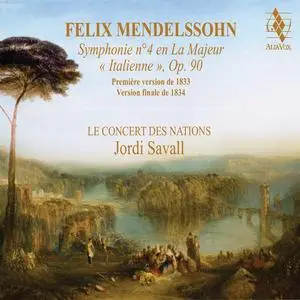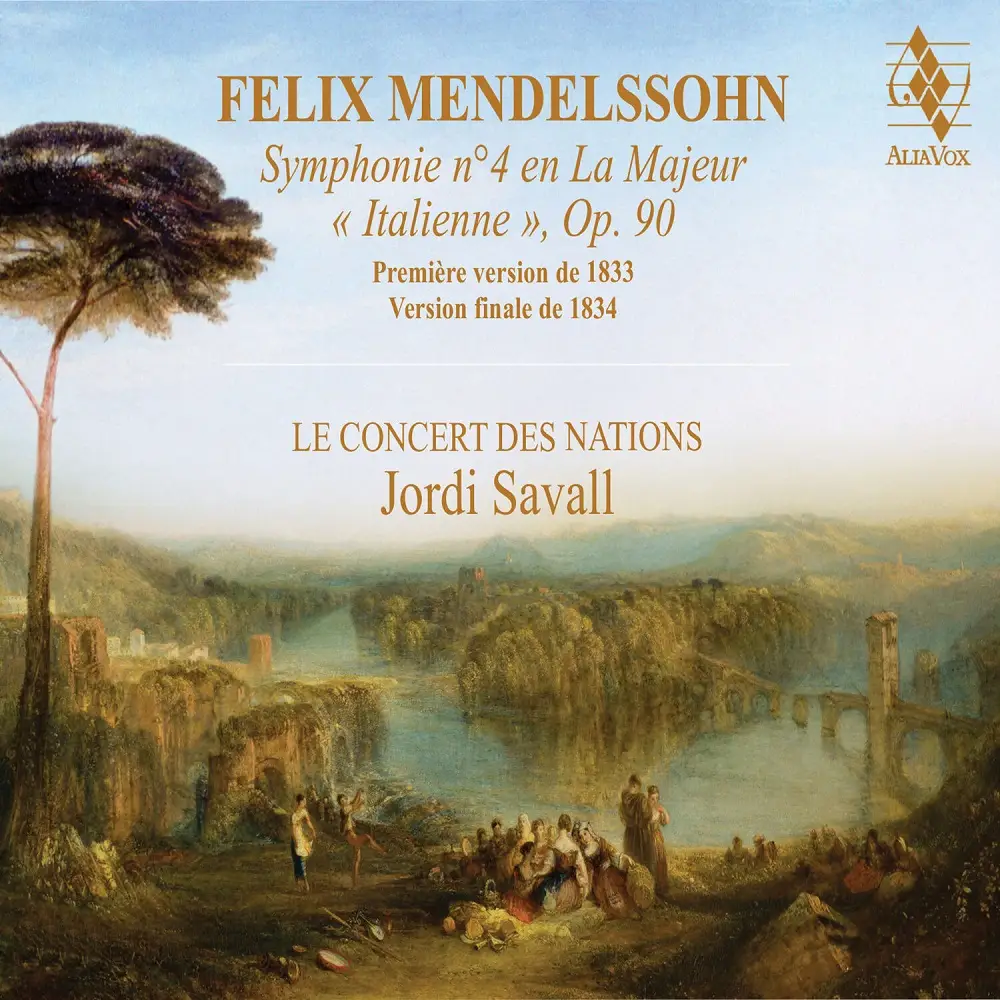Jordi Savall & Le Concert des Nations - Mendelssohn: Symphony No. 4 'Italian' (2023)
WEB FLAC (tracks) - 226 Mb | MP3 CBR 320 kbps - 139 Mb | 00:59:51
Classical | Label: Alia Vox
WEB FLAC (tracks) - 226 Mb | MP3 CBR 320 kbps - 139 Mb | 00:59:51
Classical | Label: Alia Vox
After Haydn, Beethoven and Schubert, Jordi Savall continues his journey into the 19th century with the Italian Symphony of Felix Mendelssohn, a composer he records for the first time. He delivers 2 versions of the work: the one which was performed at the wolrdwide premiere in 1833 and the revised one from 1834. The most conspicuous changes are to be found in the last tree movements. The comparison of the two scores and the performance on period instruments take us as close to Mendelssohn's work and original intention as we will ever get. Thanks to Jordi Savall's insightful conducting, there is still something to discover in Mendelssohn's most famous symphony.Tracklist:
The fact that the young Mendelssohn’s first major solo trip at the age of 21 began with a visit to Goethe in Weimar allows us to imagine that the journey he undertook to his long-awaited discovery of Italy was inspired by the one Goethe had made to that country forty-five years earlier, which he recounted in his Italian Journey (Italienische Reise). What he writes about the visit at the end of his first letter dated 21 May 1830 is both enlightening and deeply moving: “I would have to be a fool to regret the time that I spent with him. Today, I am to play him some Bach, Haydn and Mozart and take him up to the present day, as he puts it. Besides, I have conscientiously done my job as a traveller.” With these words, he affirms his desire to confront others and the events of the past, as well as the modernity of his own time.
“Mendelssohn had just turned twenty-one, (Abraham-Auguste Rolland tells us in his preface to the first French edition of Mendelssohn’s letters, published in 1864) when his father, a wealthy Berlin banker and a man distinguished as much by his intelligence as his kindheartedness, decided to send him on a trip which would, so to speak, mark the young man’s coming of age. “Go,” he told him, “visit Germany, Switzerland, Italy, France and England; study these different countries and choose, the one you like best to settle there; make yourself known, show what you are capable of, so that, wherever you settle, you will be welcomed, and people will take an interest in your work.” Accordingly, Mendelssohn left in May1830 and did not return until June 1832, after having entirely fulfilled the programme set out by his father.
A great traveller, as so many other artists have been throughout history, Mendelssohn reveals in his letters an uncommon elevation of spirit; everything that was false, vulgar or base revolted him; lies and injustice were abhorrent to him. Let us not forget that at the age of eighteen he had already composed his wonderful overture to A Midsummer Night’s Dream, and that his intellectual maturity, so ripe for someone of his age, probably led him to feel the need to confront otherness. Perhaps also because, as Montaigne (who had also travelled to Italy, Germany and Switzerland) observed, to go in search of the other is to go in search of oneself in order to be transformed. A desire for truth and authenticity, which are so clearly revealed in the words he wrote to his parents after returning from a walk along the Ponte Nomentano near Rome: “That is where you must go to find music, that is where it is to be heard everywhere, and not in theatres that are as empty as they are insipid.”
During those two years of his intense voyage he wrote numerous letters, reflections and comments to his family and friends which give us a glimpse into that phase in which the artist’s talent blossomed in contact with completely new worlds. Nicolas Dufetel writes, “To travel in space is to travel elsewhere, but it is also to travel in time. And to travel South (for that is the direction taken by the Grand Tour), like travelling to the East, is a journey into the past. Inversely, the West, following the path of the sun and light, is the future.” Through his eyes, we see successively the most beautiful places in each country, the greatest figures of the day in art, literature and politics, the theatres and the people, the city and the court, and, as Rolland points out, “and, what is even more moving and rare, we see the heart of a great artist laid bare… Blessed with a keen sensitivity to the beauty of nature, it was in the contemplation of the sea and the Alpine peaks that Mendelssohn sought inspiration; he steeped his soul in the masterpieces of Creation in order to be able to create his own masterpieces.”
Which brings us to that masterpiece, his Italian Symphony, so full of luminosity, joy, poetry and ease – all qualities that coincide with the art of William Turner and which are common traits shared by the two artists, for both were touched and inspired on their respective travels by their encounter with Italian culture. When Turner travelled to Italy between 1820 and 1829, he was already 65 years old, whereas the young composer was 21 years old when he visited the country between October 1830 and July 1831. It is extraordinary to see the extent to which their fascination for the country and its culture prompted William Turner and Felix Mendelssohn, two artists of such contrasting backgrounds and cultures, and from such different artistic expressions as painting and music, to achieve their sublime art imbued with beauty and intensity of expression.
During our years of immersion in the rich and complex world of Felix Mendelssohn’s life, we have admired the extraordinary quality and beauty of his music, but we have also been astonished by the intellectual maturity, the unerring judgement and the rare good sense revealed in his letters. As I studied the score of this Italian Symphony, I often wondered how this peculiar relationship between travel and creativity might have fostered the musical imagination. During the study and the final preparation of this symphony, and especially during our Professional Academies, I was particularly interested in this relationship, realizing that it could help us to understand how far these new experiences and encounters might have been a source of inspiration for the 24-year-old Mendelssohn. I was convinced that delving into the heart of these same sources of inspiration could help us to release once again all the light, joy and poetry contained in the two versions – the 1833 version and the final 1834 version – of this radiant Italian Symphony, which still moves us so deeply today. - Jordi Savall
01. Symphony No. 4 in A Major, Op. 90 "Italian": I. Allegro vivace
02. Symphony No. 4 in A Major, Op. 90 "Italian": II. Andante con moto
03. Symphony No. 4 in A Major, Op. 90 "Italian": III. Menuetto
04. Symphony No. 4 in A Major, Op. 90 "Italian": IV. Saltarello
05. Symphony No. 4 in A Major, Op. 90 "Italian": I. Allegro vivace
06. Symphony No. 4 in A Major, Op. 90 "Italian": II. Andante con moto
07. Symphony No. 4 in A Major, Op. 90 "Italian": III. Menuetto
08. Symphony No. 4 in A Major, Op. 90 "Italian": IV. Saltarello
–––––––––––-
DON'T MODIFY THIS FILE
–––––––––––-
PERFORMER: auCDtect Task Manager, ver. 1.6.0 RC1 build 1.6.0.1
Copyright © 2008-2010 y-soft. All rights reserved
ANALYZER: auCDtect: CD records authenticity detector, version 0.8.2
Copyright © 2004 Oleg Berngardt. All rights reserved.
Copyright © 2004 Alexander Djourik. All rights reserved.
FILE: 08 IV. Saltarello.flac
Size: 24627721 Hash: A788AD8E5E0CDC18759934F6AD78A205 Accuracy: -m8
Conclusion: CDDA 100%
Signature: E861D36EC7A38BFF4E14AC01FA84AD453EC3B8EA
FILE: 07 III. Menuetto.flac
Size: 21794611 Hash: 2D5DE44EF95BFCE3C69C62F926799A5F Accuracy: -m8
Conclusion: CDDA 100%
Signature: 09F8AC534E282B99FA4F6252DCDAAD5091C5FE0D
FILE: 06 II. Andante con moto.flac
Size: 18017215 Hash: 8FD2041EAF9C60211F8FE810F34494E5 Accuracy: -m8
Conclusion: CDDA 100%
Signature: A919BABE4E3C0ECC514733215AEF94D562CB2A4D
FILE: 05 I. Allegro vivace.flac
Size: 49522749 Hash: 8152B2C953271AE6FC78B234E35DFA1B Accuracy: -m8
Conclusion: CDDA 100%
Signature: B3AE472A4D34E2221CB98F2EA582E839A44A3A66
FILE: 04 IV. Saltarello.flac
Size: 28867952 Hash: 28167A12E782B5A13D775F0CAF7D454E Accuracy: -m8
Conclusion: CDDA 99%
Signature: 0C55DC271728710615071FCC12CB8D8DDD99ED8A
FILE: 03 III. Menuetto.flac
Size: 23338103 Hash: 08AB34F8DD9C0AFA56736FF7BAA2D398 Accuracy: -m8
Conclusion: CDDA 100%
Signature: 66041AB417538BFE3A2BCFB392C061790B64FDC2
FILE: 02 II. Andante con moto.flac
Size: 19918173 Hash: F12E1F2751E88952256A070A5C5DB8B4 Accuracy: -m8
Conclusion: CDDA 100%
Signature: CAE25D56D5275DE3627E26A76C70B6AA88D72C9B
FILE: 01 I. Allegro vivace.flac
Size: 50725191 Hash: 3B923FAE28BC2FC0896FDA034FB8E899 Accuracy: -m8
Conclusion: CDDA 100%
Signature: 335D90106C788DEBA419424A9EE79F2497ADB694
DON'T MODIFY THIS FILE
–––––––––––-
PERFORMER: auCDtect Task Manager, ver. 1.6.0 RC1 build 1.6.0.1
Copyright © 2008-2010 y-soft. All rights reserved
ANALYZER: auCDtect: CD records authenticity detector, version 0.8.2
Copyright © 2004 Oleg Berngardt. All rights reserved.
Copyright © 2004 Alexander Djourik. All rights reserved.
FILE: 08 IV. Saltarello.flac
Size: 24627721 Hash: A788AD8E5E0CDC18759934F6AD78A205 Accuracy: -m8
Conclusion: CDDA 100%
Signature: E861D36EC7A38BFF4E14AC01FA84AD453EC3B8EA
FILE: 07 III. Menuetto.flac
Size: 21794611 Hash: 2D5DE44EF95BFCE3C69C62F926799A5F Accuracy: -m8
Conclusion: CDDA 100%
Signature: 09F8AC534E282B99FA4F6252DCDAAD5091C5FE0D
FILE: 06 II. Andante con moto.flac
Size: 18017215 Hash: 8FD2041EAF9C60211F8FE810F34494E5 Accuracy: -m8
Conclusion: CDDA 100%
Signature: A919BABE4E3C0ECC514733215AEF94D562CB2A4D
FILE: 05 I. Allegro vivace.flac
Size: 49522749 Hash: 8152B2C953271AE6FC78B234E35DFA1B Accuracy: -m8
Conclusion: CDDA 100%
Signature: B3AE472A4D34E2221CB98F2EA582E839A44A3A66
FILE: 04 IV. Saltarello.flac
Size: 28867952 Hash: 28167A12E782B5A13D775F0CAF7D454E Accuracy: -m8
Conclusion: CDDA 99%
Signature: 0C55DC271728710615071FCC12CB8D8DDD99ED8A
FILE: 03 III. Menuetto.flac
Size: 23338103 Hash: 08AB34F8DD9C0AFA56736FF7BAA2D398 Accuracy: -m8
Conclusion: CDDA 100%
Signature: 66041AB417538BFE3A2BCFB392C061790B64FDC2
FILE: 02 II. Andante con moto.flac
Size: 19918173 Hash: F12E1F2751E88952256A070A5C5DB8B4 Accuracy: -m8
Conclusion: CDDA 100%
Signature: CAE25D56D5275DE3627E26A76C70B6AA88D72C9B
FILE: 01 I. Allegro vivace.flac
Size: 50725191 Hash: 3B923FAE28BC2FC0896FDA034FB8E899 Accuracy: -m8
Conclusion: CDDA 100%
Signature: 335D90106C788DEBA419424A9EE79F2497ADB694



